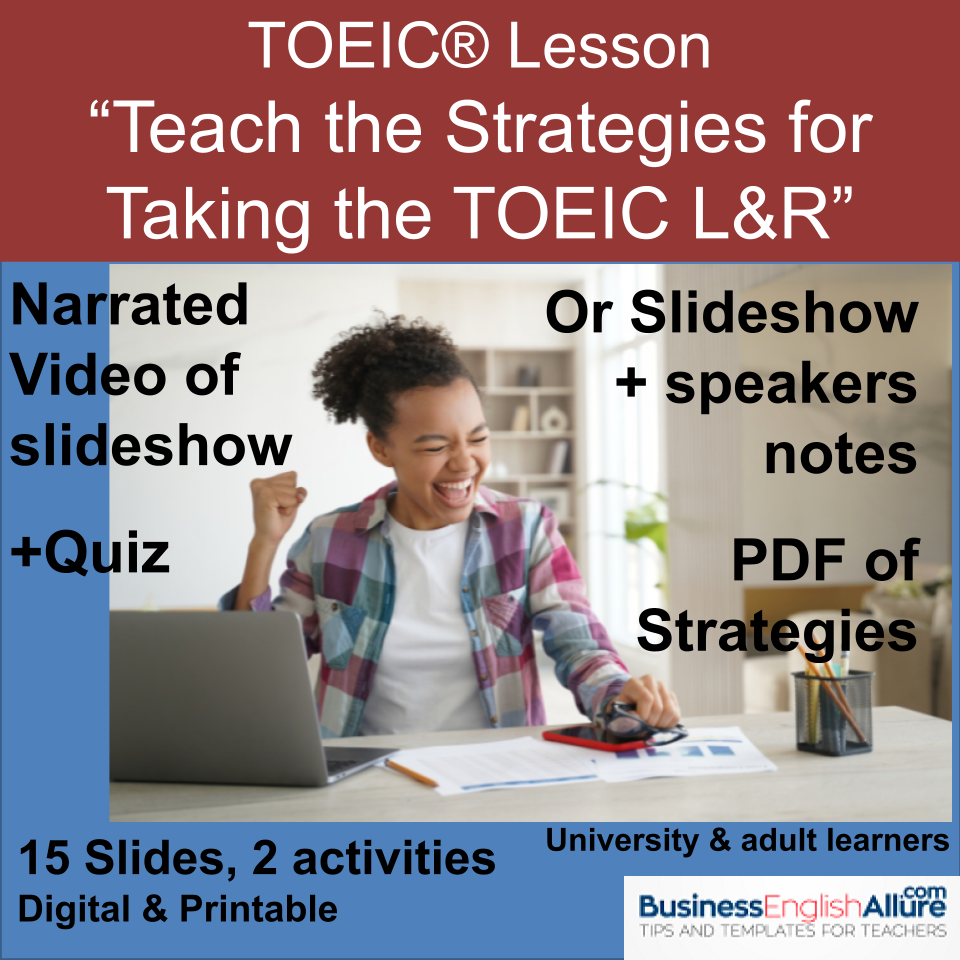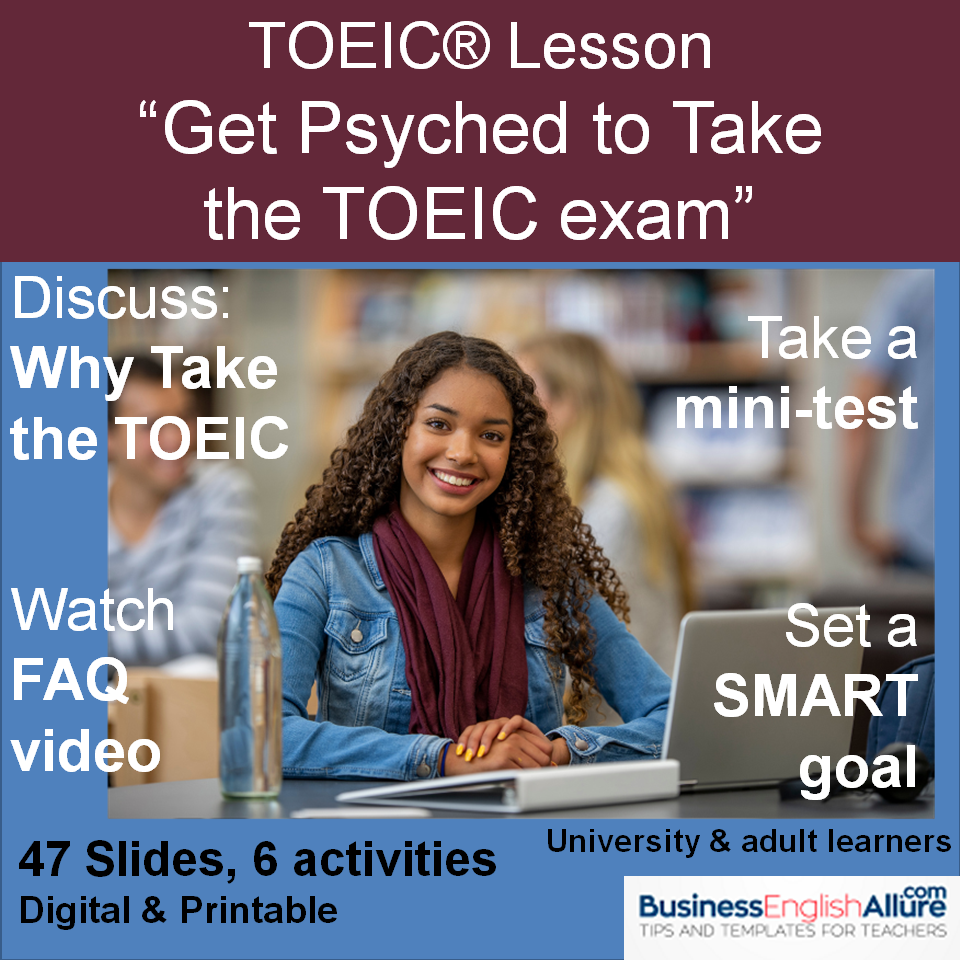Teaching TOEIC Linking Words the Fun Way

Business English students preparing for the TOEIC test will love this game because its simple, logical design will give them a quick win. Linking words (ex: but, and, because) connect two ideas and make your writing clear and precise while adding meaning. Students will learn how to choose from among 24 conjunctions and adverbs to link two ideas on the TOEIC reading test parts V and VI and improve their reading comprehension as well for Part VII.
Read about how I learned to master linking words so I could answer my student’s questions confidently and how I then designed this game to teach linking words in a fun way. Look for the blue box to download your free board game below.
The frustrating yet typical TOEIC linking word question I faced
Here’s a typical TOEIC test question about linking words. As a teacher, answer the question. Then put yourself in the shoes of an intermediate-level test taker!
1) _____________ they anticipated finishing the job in four weeks, it dragged on for over four months.
A) If B) Because C) Since D) Although
Facing a TOEIC grammar question like this one can be frustrating for many test takers. ‘Oh dear! Looks like linking words! I’ll just skip this one, or maybe guess?’
It’s frustrating for the teachers as well to explain the difference between the four answers. It involves a lot of explanation and a good grammar background. And all grammar aside, there is the phrasal word ‘to drag on’ that must be understood.
This typical example of a question from Part V comes from a practice test included in a TOEIC preparation course book published in 2002 by Oxford University Press called “Oxford Preparation Course for the TOEIC test”.
How would you explain to a confused student that answer D) is the correct choice?
Here’s what I would say:
Answer A) is incorrect because with ‘if ‘ we need a conditional sentence. The verb ‘they anticipated’ is in the simple past, so the second phrase needs ‘would drag on’.
Answers B) and C) have the same meaning ‘because’. These two linking words are used in ‘cause and result’ sentences. There is no ‘cause’ here only the result ‘it dragged on’.
Answer D) ‘although’ is correct because when we analyze the two ideas here, we can see that there is a ‘contrast’ or ‘opposition’ between the anticipated time (four weeks) and the reality (over four months). ‘Although’ is a contrasting linking word (among many others such as but, nevertheless, nonetheless, however, even though, while, whereas, in spite of, despite the fact that). The linking word ‘although’ is used at the beginning of a full sentence or the main idea (which is the case here) and it is not followed by a comma (Bingo).
Here’s what the accompanying teacher’s book said:
The correct answer is D) because ‘although’ shows the contrast intended in this sentence. Using answer A) ‘if’ would make this a conditional sentence, requiring changes to the verb tense. Answer B) ‘because’ works grammatically, but does not express contrast. Answer C) ‘since’ works grammatically, but does not express contrast.
Not such a bad explanation. But really insufficient to teach a TOEIC preparation course. Don’t worry if you couldn’t explain the correct answer. You’re going to learn everything with this game.
How did I learn to teach TOEIC linking words? The hard way.
Most ESL teachers, like me, are not linguists but we can understand and are therefore able to teach complex grammar structures like conditionals, passive voice, reported speech or relative clauses. We can either pick up a grammar book or search online for explanations on how to teach these structures.
Teaching ‘linking words’ was totally different for me. I couldn’t find a good explanation anywhere. For example, when my students would look up the linking word ‘although’ in their French/English dictionaries, they found three different words in French used for showing contrast (or opposition) between two ideas. (bien que, qui que, meme si).

Or take a look at the example with ‘however’.

I was at a loss to explain the difference in ‘meaning’ between these linking words used for contrast in English or in French. And why ‘although’ is a conjunction and ‘however’ is an adverb. And asking my colleagues was no help.
(If you’re interested in delving deeper into grammar, see the end of the post for links to explanations between linking words that are classified as conjunctions or conjunctive adverbs.)
Simply teach synonyms for ‘but’, ‘and’ or ‘because’.
What I finally deduced was that there is no ‘difference in meaning’ for all these ‘contrasting’ linking words: but, nevertheless, nonetheless, however, even though, while, whereas, in spite of, despite the fact that. They are synonyms. The only difference is in the ‘position’ in the sentence and the punctuation.
After all that researching, I now know what my business English students need to know about ‘linking words’ for the TOEIC test.
1) They need to be able to recognize a linking word when they see one among the four answer choices.
2) And to ‘classify’ them for expressing ‘contrast or opposition’, ‘cause/result’ or ‘addition’.
3) Students need to practice analyzing complex (two-part) sentences to be able to judge whether the sentence is expressing ‘contrast’, or ‘cause/result’ or simply ‘addition’?
4) After recognizing the classification (or context) intended, test takers need to verify the position of the linking word in the sentence. Is the linking word used in the main idea or second idea? Is it placed at the beginning, or the end, or nestled in the middle of the ‘idea or clause’.
5) And finally, test takers can double-check their answer choice with the punctuation. Is the linking word followed by a comma, or preceded by a semicolon?
These five things to keep in mind during a fast-paced, stress-intensive TOEIC test are challenging, but doable with practice. It’s challenging as well to teach these five steps but doable with this game I developed.
Here’s the free linking word game
This game is designed for the TOEIC reading test sections V and VI but could be used for teaching the use of linking words for intermediate-level students to embellish and add clarity to emails and presentations.
Before class
1) Download these files

2) For each Handout file:



Printing Instructions:
Print Page 1 & 2 on colored paper. A different color for each team.
Plasticize Page 1 & 2. Cut up Page 1 into cards. Cut up answer sheet from ‘Handout Addition file page 1’. Page 2 is the board for the game.
Store all 52 ‘sentence’ cards and 26 ‘linking word’ cards separately by color with the three boards. Like this:
Print the three blank boards on white paper, one copy per team. Plasticize the three pages for each team if you can.

Linking Words are classified according to context
There are so many different linking words used in many different contexts, but we will focus on the 26 common linking words found among the grammar questions in sections V and section VI of the TOEIC® test.
We will focus on three categories or ‘contexts’.
| Contrast or Opposition Synonyms for ‘But’ | Cause and Result Synonyms for ‘because/so’ | Additional Information Synonyms for ‘And’ |
| but | because | and |
| although | since | as well |
| even though | due to | as well as |
| however | due to the fact that | besides |
| despite | owning to the fact that | apart from |
| despite the fact that | so | in addition to this |
| in spite of | therefore | moreover |
| while | as a result | furthermore |
| whereas | consequently |
At the beginning of the class:
- Copy the table above on the whiteboard or project it on a screen.
- Divide your students into color-coded groups which match the colored paper you’ve used to print your game boards. (See this previous post of mine for instructions on forming groups and choosing a person to represent the group in the final stopwatch game. /how-to-engage-millennials-in-eslefl-class/).
- BIG SELLING POINT: Start off by telling your students that linking words ‘link’ two ideas. Explain to them that they will definitely see these words on the TOEIC® reading test. I’ve seen some practice tests with up to eight out of the 40 questions in Section V concerning linking words.
First step to the game: pass out the ‘sentence cards’.
- Have them arrange the 26 cards in numerical order into two parallel columns, column ‘a’ and column ‘b’. This is the easy part.
- Give each group the three ‘blank’ board games from the file: Blank game boards linking words.doc . Be sure the groups understand that one board is for the sentences linked with ‘and’, the next board for sentences linked with ‘but’ and the third board for sentences linked with ‘because/so’.
- Ask the students to link the two ideas in 1a and 1b by trying to link the two ideas with ‘but’ , or trying ‘because or so’ or simply by trying ‘and’. Then place the sentence cards on the appropriate board.
1b I like the VW Golf. | 1a I like the Alpha Romero 147. |
Answer: Hopefully they will see that ‘and’ is the correct linking word and place sentences 1a and 1b on the ‘and’ board. (TIP: when the same verb is used in idea ‘a’ and idea ‘b’, then it’s usually ‘and’).
Now try linking sentences 2a and 2b with ‘but’, ‘and’ or ‘because/so’ and place the cards on the appropriate board.
2a It was cheaper. | 2b I bought a Twingo. |
Answer: ‘because/so’ works. We can see a ‘cause and result’ relationship here. (TIP: ‘because’ can go in the first idea column or the second idea column. ‘So’ is always a second idea linking word).
Now try linking sentences 3a and 3b with ‘but’, ‘and’ or ‘because/so’ and place the cards on the appropriate board.
3a I prefer the VW Golf. | 3b I bought a Twingo. |
Answer: ‘but’ is the correct linking word. We see a ‘contrast’ here because there are two different kinds of cars and there is a contrast between what ‘I prefer’ and what ‘I bought’.
Give the groups plenty of time to go through all 26 sentences. You might need to explain some vocabulary or help them to see the ‘linking’ context.
Now would be a good time to explain to each group individually that most linking words are followed by a complete sentence (subject + verb+ object). However, a few linking words are followed by a noun or a verb in +ing which serves as a noun. Examples: despite, in spite of, due to, as well as, apart from, besides. The groups will see the word ‘noun’ on the blank answer sheets. These squares are reserved for ‘noun clauses’.
Here are the answers in numerical order. Pass out the answer card to each group as they finish.
Contrast Answers = 3, 4, 8, 14, 16, 23, 26, 13 (noun), 19 (noun)
Reason/Result answers = 2, 5, 9, 11, 12, 17, 20, 22, 25 (noun)
Addition answers = 1, 6, 7, 10, 15, 18 (noun), 21 (noun), 24 (noun)
Step Two: Pass out the board games printed on colored paper with the linking words organized in columns. Have the students simply transfer the sentence cards from the whiteboard to the colored board. The point here is for them to see clearly that these linking words are only synonyms. We choose different linking words for variety and that they all are interchangeable. The only difference is the place in the sentence or if it is a noun phrase.
Point out that the punctuation is shown in bold for each linking word. TIP: For example, ‘however’ is always followed by a comma whereas ‘although’ is not. This little tip may help your students choose the correct linking word on the TOEIC just by noticing the punctuation.
Step Three: Pass out the colored cards with the individual linking words. Now the groups will place the linking word cards on the appropriate blank (white) board for the context and in the appropriate column, using the colored boards as a guide. (TIP: you might need to help some groups with the noun phrases. For example, noticing the difference between ‘despite’ and ‘despite the fact that’. )
Each person in the group will need time to practice with and without a stopwatch. Hopefully, the stronger members will help the weaker ones. When you feel that just about everyone in each group has had a chance to practice, choose at random a representative for the stopwatch game. As each group is timed, put up the scores on the board. The winning team gets M&Ms.
QUIZ: Let the class know that there will be a quiz in the future (during the next class, or at the end of this class). Young men especially like to be tested and graded. Don’t forget to download the quiz when you download the game.
Final Tips:
- No need to use grammatical terms like ‘independent clause’. Just talk about ‘first idea’ or ‘main idea’ and the ‘second idea’.
- You will need to explain that some ‘ideas’ are not full sentences with a subject + verb + and object. Some ‘ideas’ are only nouns. Examples: “Despite the rain, we still went bicycling.” “ Due to downsizing, we plan to lay off 50 people.” Sometimes the noun looks like a verb +ing.
- Try to persuade your students to not translate these linking words into their own language. Get your students to accept them as simply synonyms of ‘but’, ‘and’ or ‘because/so’. If they insist on translating, make sure they chose a corresponding linking word that is used in the same place in the sentence (ie: in the first idea or in the second idea’ and with the same punctuation if possible).
Here’s some extra reading below to clarify the difference between conjunction and adverb (only if you’re curious)
1) Help to answer questions about ‘Linking words are always conjunctions? or adverbs? ‘

//www.chompchomp.com/terms/conjunctiveadverb.htm
2) Help ‘How do I punctuate linking words?’

//writing.wisc.edu/Handbook/ConjAdv.html
3) Help to answer student questions about ‘Is it a preposition, adverb or conjunction?’

//random-idea-english.blogspot.fr/2011/05/is-it-proposition-is-it-conjunction-or.html
I hope this game will encourage business English teachers to review linking words as part of a TOEIC® preparation course and to use this game for students who would like to improve their writing skills for emails and presentations. The use of linking words enriches and clarifies writing. And as we say in the States “It separates the men from the boys.”
Subscribe and leave a comment
Maybe you have some questions or some more tips for teaching linking words? Why not leave a comment.? Also, feel free to share this game with your colleagues and encourage them to sign up for the newsletter.
Subscribe to my newsletter to receive more lesson plans for business English and TOEIC preparation classes as well as EdTech tips for going digital in your classroom.
Need some more TOEIC preparation games?
Here are four business phrasal word games + crossword puzzles for revision + quiz with authentic business passages in the TOEIC style. Have fun teaching TOEIC preparation. /4-phrasal-verb-games-business-english/
TOEIC to be Updated in June 2018.
Read all about the upcoming changes and its implications for you as a TOEIC preparation teacher and your students. /toeic-test-changing-in-june-teachers-get-ready/













Hi, I can’t download this game but I’d love to… can I have access please?
Thanks
So sorry for the delay Claire. I had a bug in my G Drive. Here’s the link. //drive.google.com/drive/folders/0BzswY1qxcnJUNkZtanJvdFJuclU?resourcekey=0-v1nJ8_MQG6CtKwLikBeReg&usp=sharing
Best regards,
Ellen Baker Duboois